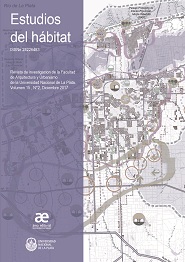Residential energy saving in arid cities
Environmentally efficient strategies with green roofs incorporation
DOI:
https://doi.org/10.24215/24226483e023Keywords:
Green Roofs, Thermal Behavior, Energy Saving, Arid Cities.Abstract
The adoption of non-traditional green structures in arid cities -new technologies such as green roofs and green walls- constitutes an strategies that controls the indoor high temperatures in summer at building scale, and mitigates the urban heat island at urban scale. This work evaluates the effect of green roofs with adapted species to water deficit -Aptenia cordifolia and Sedum spectabile- on the thermal efficiency of indoor spaces. The thermal performance during summer and winter has monitored in experimental boxes. The results indicate that in the green roofs, indoor summer temperature decreases 1,6 °C, this generate an energy saving for refrigeration of 30 to 35%. In winter, diurnal energy saving of 2-4% is observed. This data indicate that the design of these new technologies should be assessed at local level to maximize energy efficiency and ensure urban-building sustainability.
Downloads
Metrics
References
Alexandri, E. & Jones, P. (2006). Temperature decreases in as urban canyon due to green walls and green roof in diverse climates. Building and Environment - Science Direct - Elsevier Ltd . Disponible en: https://doi.org/10.1016/j.buildenv.2006.10.055
Cárdenas, G. J. (2011). Matriz energética argentina. Situación actual y posibilidades de diversificación. Revista de la Bolsa de Comercio de Rosario. 32-36. Disponible en: http://www.eeaoc.org.ar/upload/contenido/pdf/20120228122933000000.pdf
Dunnett, N. & Kingsbury, N. (2004). Planting Green Roofs and Living Walls. Timber Press Inc, Oregon.
Erbs D.G. (1987). Degree Day for Variable Base Temperatures. Proceedings of International Solar Energy Society (ISES). (6), pp. 387-391. Ed. J. Hages and W. Kollar.
Flores Asin, J. E., Martinez, C. F. & Cantón, M. A. (2013). Tecnologías verdes. Potencial de aplicación en el Área Metropolitana de Mendoza (AMM). Acta de la XXXVI Reunión de Trabajo de la Asociación Argentina de Energías Renovables y Medio Ambiente. (1), pp. 05.115-05.120, 2013. ISBN 978-987-29873-0-5
Flores Asin, J. E., Martinez, C. F.; Cantón, M. A. & Correa E. N. (2015). Impacto de cubiertas vegetadas en el ahorro energético del parque edilicio del área metropolitana de Mendoza (AMM). Acta de la XXXVIII Reunión de Trabajo de la Asociación Argentina de Energías Renovables y Medio Ambiente. 3, pp. 05.81-05.89, 2015. ISBN 978-987-29873-0-5
La Roche, P. (2009). Low Cost Green Roofs for Cooling: Experimental series in a hot and dry climate. PLEA 26th Conference on Passive and Low Energy Architecture, Quebec, Canada 22-24 June 2009.
Pincetl, S. (2012). Nature, Urban Development and Sustainability – What New Elements are Needed for a More Comprehensive Understanding? Cities: Current Research on Cities, 29:S32-S37 Science Direct - Elsevier Ltd Disponible en: http://dx.doi.org/10.1016/j.cities.2012.06.009
Qiu G., Li H., Zhang Q., Chen W., Liang X. & Li X. (2013). Effects of Evapotranspiration on Mitigation of Urban Temperature by Vegetation and Urban Agriculture. Journal of Integrative Agriculture, (12), pp. 1307-1315. Science Direct - Elsevier Ltd Disponible en: https://doi.org/10.1016/S2095-3119(13)60543-2
Rosenfeld E., San Juan G, Discoli C, Martini I, Ferreyro C. & Barbero D. (2007) Ahorro de energía en el sector residencial. Su contribución a la disminución de gases de efecto invernadero (GEI). Revista AVERMA. (11): 07.31-07.38.
Teemusk A, Mander U. (2010). Temperature regime of planted roofs compared with conventional roofing systems. Ecological Engineering 2010; 36:91-105. Science Direct - Elsevier Ltd Disponible en: https://doi.org/10.1016/j.ecoleng.2009.09.009
Wong, N. H.; Tan A. Y.; Tan, P. Y; Wong, N.C. (2009). Energy Simulation of Vertical Greenery Systems. Energy and Buildings v.41, n,12, p.1401-1408. Science Direct - Elsevier Ltd. Disponible en: https://doi.org/10.1016/j.enbuild.2009.08.010
Downloads
Published
How to Cite
Issue
Section
License
Acorde a estos términos, el material se puede compartir (copiar y redistribuir en cualquier medio o formato) y adaptar (remezclar, transformar y crear a partir del material otra obra), siempre que a) se cite la autoría y la fuente original de su publicación (revista y URL de la obra), b) no se use para fines comerciales y c) se mantengan los mismos términos de la licencia.








.jpg)

















